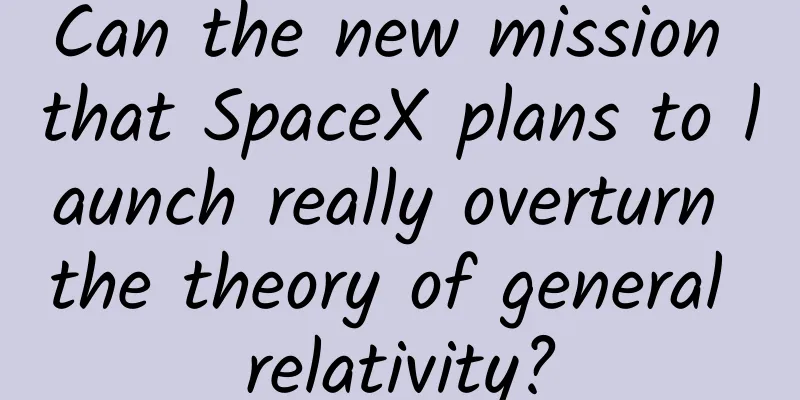Can the new mission that SpaceX plans to launch really overturn the theory of general relativity?

|
Introduction: Finding out the true nature of dark matter is one of the most core issues in contemporary cosmology and even physics. Unfortunately, despite decades of intensive searches, no conclusive evidence of the existence of dark matter has been found. Therefore, alternative theories of dark matter have their own room for development. Some theories even lead to conclusions that subvert the foundations of existing physics, such as the quantum inertia hypothesis, which no longer regards inertia as an inherent property of objects. The SpaceX Transporter-8 mission, originally scheduled for June 12, was originally going to test the actual effect of the quantum inertia hypothesis - the IVO quantum engine. But a few hours before the launch of Transporter-8, the development team of the quantum engine suddenly announced that it would withdraw from the launch mission. Written by | Jiawei On June 12 (UTC time), the Falcon 9 rocket of SpaceX, the space transportation company founded by Elon Musk, successfully launched the Transporter-8 mission. According to the original launch plan, the mission should also test the feasibility of a black technology device. The principle of this device is based on the quantum inertia hypothesis. The device is called IVO Quantum Drive, which is a pure electric propulsion system. The appearance is as follows: IVO quantum drive engine | Source: IVO Ltd. However, it seems that most physicists believed from the beginning that this experiment was a pseudo-scientific hype and a waste of money, and that the IVO quantum drive engine would definitely not succeed. Why does the academic community have such a negative view on this theoretical technology? What does quantum inertia mean? The story begins with the discovery of dark matter... 1 In the 1930s, Swiss astrophysicist Fritz Zwicky noticed that the Coma Cluster of galaxies was rotating too fast. Considering the amount of gravity provided by the mass of the galaxies, their centripetal force could not support the high-speed rotation of the galaxies - so the galaxies should have fallen apart. But they clearly didn't. M101 galaxy, with a rotation curve that cannot be explained by visible matter | Image source: NASA/CXC/SAO/D. Hartmann/JPL-Caltech There are basically two paths before us: either Newton's second law, or even the law of gravity, is wrong, or we add something else to the galaxy to fill in the mass. There are currently two main dark matter candidates proposed by scientists: relatively heavy weakly interacting massive particles (WIMPs) and a hypothetical extremely light particle called the axion. Astronomers from the University of Hong Kong proposed in the journal Nature Astronomy this year that the "true identity" of dark matter can be confirmed with the help of "gravitational lenses" and "Einstein rings". | Image source: ESA/Hubble & NASA There have been numerous experiments trying to detect so-called dark matter, or even create it, but so far, none have been successful. At the same time, although the above-mentioned types of dark matter models are generally accepted by many scientists, there are still some unexplained problems. One of them is the problem of the so-called galactic halo cusp, which proposes that the density of dark matter in galaxies is inconsistent with the so-called N-body simulation results. So there has always been a small group of physicists who have chosen the second path and tried to revise Newton's laws. 2 The alternative to dark matter is called Modified Newtonian Dynamics (MOND) or the Milgrom dynamics framework. This theory - first published by physicist Mordehai Milgrom in 1983 - suggests that if we modify Newton's second law and recalculate the gravity of galaxies and stars, we don't need dark matter to fill the mass gap in the universe (for a detailed introduction to the MOND theory, please see the previous article of "A pair of competing scientific theories: dark matter and modified gravity theory"). In 2021, scholars supporting MOND finally constructed a MOND model that is compatible with relativity. But overall, it still feels patchwork. The extremely unnatural part is that the threshold of 10^(-10)m/s^2 where Newton's laws fail must be "artificially set" to match the observed data, and no satisfactory reason is given for this. 3 In this situation, some people tried to find a third way: Mike McCulloch, a physicist at the University of Plymouth, proposed the Quantum Inertia (QI) theory in 2007. This is a theory of inertia that attempts to use relativity and quantum mechanics to explain the reaction force that an object experiences when it is accelerated. 4 Although not many people believe in the QI theory, it has an advantage that the dark matter theory and MOND theory do not have, that is, there is an immediate opportunity to test the theory. Since QI predicts that we can get thrust and energy from the vacuum, this leads to the IVO Quantum Drive mentioned at the beginning of this article, which is a magical engine designed by McCulloch based on the QI principle. In 2018, the Defense Advanced Research Projects Agency (DARPA), a research agency under the U.S. Department of Defense responsible for developing emerging technologies for military use, awarded a $1.3 million contract to researchers in the field of QI to study quantum inertia. This move quickly sparked controversy, because a considerable number of physicists believe that QI is pseudoscience, and DARPA's investment in it has become a disguised endorsement of pseudoscience. As for why DARPA would invest in such seemingly unreliable technology, this is actually related to the official nature of DARPA. As of 2021, their mission is to "make key technology investments for national security." So DARPA doesn't mind investing in some relevant technologies appropriately - even if it turns out to be pseudoscience, it's only a few million dollars; if it succeeds, it will be an unprecedented major breakthrough in the field of science - it seems worth taking the risk. Of course, DARPA will not just keep quiet and invest money. In the contract, it requires McCulloch and his colleagues to prove the feasibility of this fluidless engine. The so-called "fluidless engine" refers to an engine that can generate reverse thrust without spraying anything. In other words, it does not obey the law of conservation of momentum. The IVO quantum drive engine can obtain thrust directly from the vacuum, so it is also a fluidless engine. The previous generation of fluidless engines, the legendary EMDrive, has been falsified. As mentioned at the beginning, the scientific community generally believes that this is a hoax (just like the first generation of fluidless engines). But for the sake of fairness, please allow me to put the other side's statement below. According to the official statement of IVO, "IVO quantum drive engine is a wireless energy transmission technology based on capacitive air transmission (CBAT) technology. CBAT can reduce the size of satellite batteries by 50% and does not require fuel. The system can generate 52 millinewtons (mN) of thrust per watt of electricity and is much lighter than existing ion engines. The system uses solar energy as a power source and has unlimited maneuverability." I would like to remind you that the above statement comes entirely from IVO's own claims. It "generates 52 millinewtons (mN) of thrust" and so on. At present, outsiders have not seen the experimental report at all and cannot understand its mechanism. To quote Telehey, current IVO Ltd. co-founder, again with his enthusiastic vision for the future: “The IVO Quantum Drive really does completely break free from the current limitations of modern space propulsion technology. It is the first purely electric propulsion unit, which means that it only requires electricity to operate. Gone are the days of complex fuel systems that require special fuel solutions to propel a spacecraft. As long as we have electricity, we have thrust, which is why unlimited Delta-V is possible for the first time ever. Due to its self-contained nature, this is the first propulsion unit that can be completely built inside a spacecraft.” “Our collaboration with our commercial partner (Rogue Space Systems, which bridged IVO Ltd. and SpaceX to make this experiment possible) was born out of our shared passion for innovation and the ultimate goal of expanding human capabilities. For thousands of years, humans have looked up at the stars with wonder and longing. Now, for the first time in human history, we have the ability to reach out and touch these faraway places. Our organizations need to take this more seriously, and together, IVO and Rogue are going to make history.” Well, if IVO Quantum Drive successfully and convincingly demonstrates the application of QI theory in space, then, as the co-founder says, they will make history. From then on, concepts such as the Ark and the generation spacecraft will no longer remain in science fiction novels and movies. If this is true, McCulloch will become the Einstein of the new era. Modern physics, both theoretical physics and astrophysics, will be completely overturned. Just as relativity replaced Newtonian mechanics, QI theory will replace relativity and throw the concept of dark matter into the garbage heap of history. All current and future observational data, such as the total mass of the universe, age, radius of the visible universe, etc., need to be reinterpreted by introducing QI theory. But the key is whether it can provide "successful and convincing" experimental evidence. It is not enough to show that the IVO quantum drive engine can generate thrust in a single experiment. The first generation of fluidless engines also showed thrust, but after careful experimental design, we know that the tiny thrust actually comes from environmental interference. (As for how to be "convincing", we have to bring out the concept of decisive experiments. Unfortunately, it is too limited to explain in detail here.) On the other hand, if the experiment does not show that the quantum engine can generate thrust, we must also consider whether there are interference factors, such as accidents such as the device breaking down during the launch process (or as it is now, the orbital experiment is suddenly announced to be postponed before the launch.). Even supporters of the QI theory can untie themselves from IVO Ltd. and claim that IVO is just a fraudulent company under its name. Well, although the inspection time has been postponed to October, let’s wait and see. Update Note: The original content of this article was published 20 hours before the launch of the Transporter-8 mission. However, a few hours before the launch (UTC time June 12), IVO Ltd. suddenly announced through its official Twitter that the test mission of the IVO quantum engine has been rescheduled to SpaceX Transporter 9, which will be launched in October this year. Therefore, the launch plan in this article has been revised based on this latest news.
References 1 DARPA Is Researching Quantized Inertia, a Theory Many Think Is Pseudoscience (vice.com) 2 An Alternative Theory of Inertia will Get Tested in Space - Universe Today 3 Physics - Dark Matter Alternative Passes Big Test (aps.org) 4 Evidence of "modified gravity" strengthens dark matter alternative (newatlas.com) 5 Physicists Found a Way to Trigger The Strange Glow of Warp Speed Acceleration : ScienceAlert 6 How quantised inertia gets rid of dark matter | Mike McCulloch | TEDxPlymouth University (Mike McCulloch, the inventor of quantum inertia theory, introduced his theory at TED in March 2018.)
Special Tips 1. Go to the "Featured Column" at the bottom of the menu of the "Fanpu" WeChat public account to read a series of popular science articles on different topics. 2. Fanpu provides a function to search articles by month. Follow the official account and reply with the four-digit year + month, such as "1903", to get the article index for March 2019, and so on. Copyright statement: Personal forwarding is welcome. Any form of media or organization is not allowed to reprint or excerpt without authorization. For reprint authorization, please contact the backstage of the "Fanpu" WeChat public account. |
>>: Sanxingdui, how many mysterious stories are there?
Recommend
Why do birds migrate?
Birds migrate to different areas to breed or over...
How much does bidding hosting usually cost per month? How to do bidding hosting?
Many clients don’t quite understand these issues....
Can drinking a glass of ice water after exercising in hot weather put your life in danger?
First, let’s understand what sudden death is . Su...
There are projects that sell for hundreds of dollars outside. Just copy and paste without thinking. One hour a day, earning 200+. Anyone can do it
It is said that someone outside is selling this pr...
Why is it so difficult to kill the “invincible” cockroach? Let’s see the battle between humans and cockroaches →
Cockroaches, scientifically known as Blatta, are ...
What are the functions of the Guangzhou Insurance Mini Program? How much does it cost to develop a WeChat insurance mini program?
Not long ago, a colleague of mine bought another i...
Practical Tips | Mobile Internet Million-level Channel Promotion Methodology
The entire channel operation will be carried out ...
What is the difference between the 5 yuan and 25 yuan toothpaste in the supermarket? How to choose? Don't waste money anymore!
Many people may have seen promotions like this: t...
Pilots are not allowed to have scars, but why can injured pilots continue to fly?
As we all know, the medical examination for pilot...
Deconstruction and reconstruction behind product operations: Why was P&G's brand empire "dismembered"? Why can Toutiao become a platform?
1. Unbundle I mentioned a point in the article &q...
The 2024 Feifan R7 has been greatly reduced in price. Who will be the next brand to rush into the market?
SAIC Feifan, whose annual sales volume is only a ...
How does 360 make money for free? How does 360 company make money?
360 has a lot of software, among which the ones w...
Analysis of Xigua Video Product Promotion
From the perspective of a new product developer, ...
These mobile phone functions and skills can solve holiday battery anxiety
Although there has not been a revolutionary impro...
What are the conditions for opening a Douyin store? What are the requirements for setting up a Douyin store?
Since the launch of Douyin Stores , more and more...









